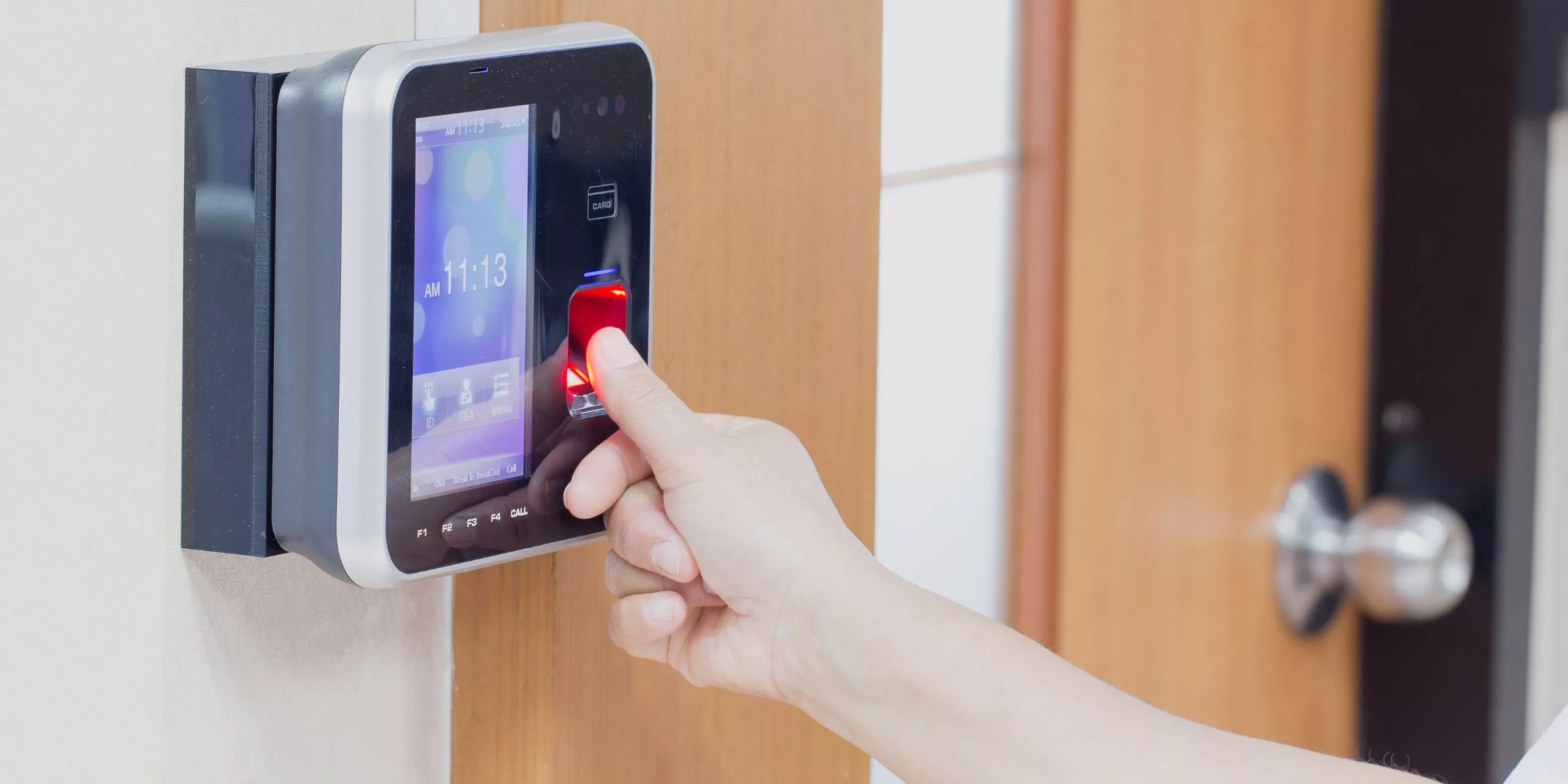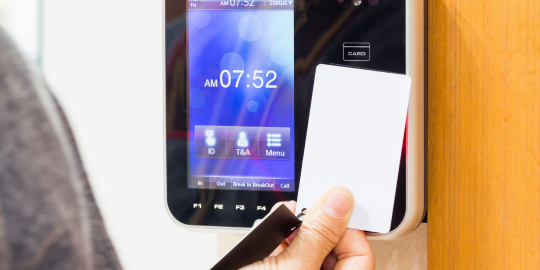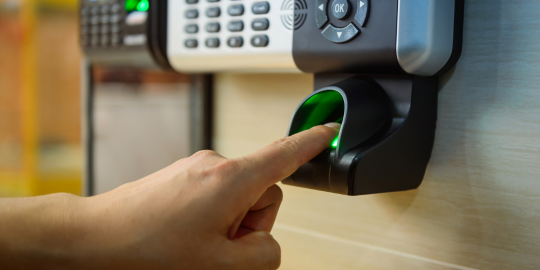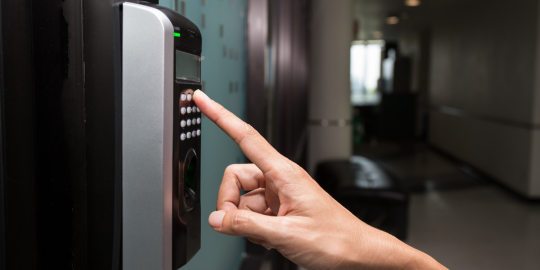Definition and Purpose of a Door Access Control System
A door access control system is a commercial security solution. In brief, access control regulates and manages the entry and exit of individuals to specific areas or premises. Typically, our systems consist of both hardware and software access components. Our systems authenticate and authorise individuals based on predefined criteria. For example, credentials or biometric information.
The primary purpose of our door access control system is to enhance security. Subsequently, it must prevent unauthorised access to sensitive or restricted areas. Doing so allows organisations to control and monitor who can enter specific locations within their premises. Thus, ensuring that only authorised individuals gain entry.

Importance of a Door Access Control System in Security
Firstly, access control plays a crucial role in ensuring the security and integrity of systems. Particularly networks, areas and sensitive information within an organisation. While often overlooked, access control is a fundamental aspect of maintaining a robust security posture. Its significance cannot be overstated.
Secondly, organisations possess vast amounts of data. Particularly trade secrets, customer information, financial records and proprietary research. Meanwhile, unauthorised access to such information can lead to severe consequences. For example, a business may face financial loss, reputational damage and legal ramifications.
Finally, implementing access control mechanisms ensures that only authorised individuals or entities can access specific resources, mitigating the risk of data breaches and unauthorised disclosures.
Components of Door Access Control Systems
Authentication Methods
In today’s security-conscious world, controlling access to buildings and restricted areas is of paramount importance. So how do we authenticate our visitors? Authentication methods are critical.
Firstly, authentication methods serve as the first line of defence. By utilising authentication, we can maintain the integrity of our access control systems. We must verify the identity of individuals attempting to gain access to our resources, systems and facilities.
Here are some common authentication methods:
Card-Based Authentication
Card-based authentication is a widely used method in door access control systems. Being that this method simply involves the use of access cards or keycards. These cards work by utilising embedded chips or magnetic strips along with software. Typically, we install card reading devices at building entry points. For example doors or turnstiles. Our systems are then responsible for reading the information stored on access cards and either granting or denying access.
Employees or authorised individuals are issued these cards based on permissions. We then present our card to the reader to gain access. Finally, the access control system verifies the card’s information and grants access accordingly. Similar to Paxton and their Paxton Net2 system.

Biometric Authentication
Biometric authentication methods use unique physiological or behavioural characteristics of individuals to verify their identity. For example, fingerprint recognition, facial recognition or iris scanning. Overall, the use of unique characteristics ensures a higher level of security.
- Fingerprint Recognition: The unique patterns present in an individual’s fingerprints.
- Iris Recognition: Capture and analyse the intricate patterns within the iris of the eye.
- Facial Recognition: Maps and matches specific facial features to authenticate.
- Voice Recognition: Analyse vocal characteristics, such as pitch and tone.
Biometric readers capture the biometric data and compare it with stored templates to authenticate the user.

PIN-based Authentication
PIN-based authentication is a widely adopted method in computer-based access control systems. This authentication method involves users entering a unique Personal Identification Number (PIN) on a keypad or touchpad to validate their identity. Utilising this method provides an additional layer of security. Especially when used in conjunction with card-based systems.
PIN-based authentication strikes a balance between security and user convenience. In fact, it is commonly employed in scenarios where a moderate level of security is required. For example, office buildings, residential complexes or educational institutions. However, organisations should be mindful of potential vulnerabilities, such as PINs being stolen or observed. We must consider implementing additional authentication factors. It is recommended that we use biometrics to establish a stronger and more robust multi-factor authentication system.

Benefits of Implementing Door Access Control Systems
Enhanced Security
Door access control systems are a vital tool for bolstering security measures. We can selectively allow or deny entry to individuals based on pre-established criteria. Additionally, these systems effectively safeguard physical spaces, digital resources and sensitive data. For example, we can protect buildings, rooms and servers. When we prevent unauthorised access, we significantly reduce the risks of theft, vandalism and unauthorised entry.
Restricting Access By Using Door Access Control Systems
A door access control system effectively restricts access to specific areas by regulating entry. For example, through doors or gates. When employing these systems, we ensure that only authorised individuals can gain entry. We then prevent unauthorised personnel from accessing sensitive areas. Our systems are capable of assigning access levels based on user roles and permissions. For that reason, restricted spaces such as server rooms, laboratories and executive offices remain secure.
Improved Safety For Door Access Control Systems
Door access control systems play a crucial role. We can ensure a higher level of safety for our occupants by preventing unauthorised individuals from entering the premises. This is especially vital in high-security environments like research facilities or government buildings. Given that personnel safety and the protection of sensitive information are paramount.
Audit Trail and Activity Monitoring
Many door access control systems offer an audit trail feature. We are able to record essential information such as entry and exit times. Additionally, we can monitor access attempts (granted or denied) and user identification. Once collated, this valuable data assists in investigating security breaches and monitoring employee attendance. In other words, are we complying with regulatory requirements.
Time and Attendance Tracking
Often, we will integrate door access control systems with time and attendance software. In doing so, we can provide accurate tracking of employee hours. In addition, this integration eliminates manual archaic methods of attendance tracking. We are able to reduce errors and facilitate efficient payroll management.
In summary, by implementing door access control systems, businesses can:
- Significantly enhance their security measures.
- Restrict access to sensitive areas.
- Ensure the safety of occupants.
- Maintain an audit trail for monitoring and compliance purposes.
- Streamline time and attendance tracking for improved workforce management.
Conclusion
Door access control systems play a critical role in controlling access. We can enhance security in various environments. For example, corporate offices, government facilities, hospitals and educational institutions. Using these systems, we can provide a range of benefits, including:
- Enhanced security.
- Restricted access to sensitive areas.
- Improved safety.
- Audit trail capabilities.
- Time and attendance tracking.
By implementing door access control systems, organisations can effectively manage and monitor entry into their premises. We are ensuring that only authorised individuals can access specific areas. The use of authentication methods such as card-based, biometric, or PIN-based verification adds an additional layer of security. We must mitigate the risk of unauthorised access and potential security breaches.
Moreover, these systems offer scalability. We are allowing organisations to expand their access control capabilities as their needs evolve. Integration with other security systems and remote management capabilities further enhance the effectiveness and convenience of door access control systems.
Overall, door access control systems provide a comprehensive and reliable solution for regulating access. We are able to safeguard sensitive information and maintain a secure environment. By investing in these systems, organisations can proactively protect their assets, mitigate risks and ensure the safety and integrity of their premises and resources.